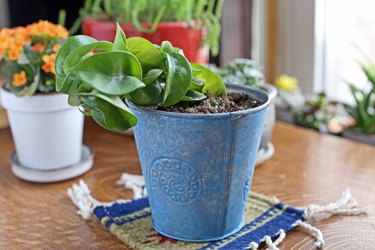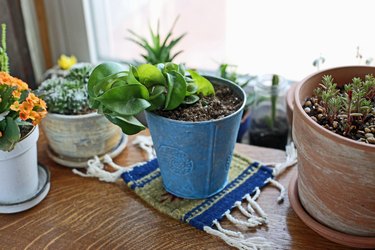
Hindu rope plants (Hoya carnosa "Krinkle Kurl") earned their common name with their 12- to 15-inch-long stems, which have a pendulous habit, like a length of rope. Usually grown as houseplants, they will also survive outdoors in U.S. Department of Agriculture plant hardiness zones 9a through 11. Hindu rope plants look best and live longer when provided with regular care year-round, but those care requirements vary according to the season.
Seasonal Watering
Video of the Day

Hindu rope plants tolerate dry soil well, but they will look best if you water them regularly in summer. Water deeply but infrequently during the summer, saturating the soil and letting it dry out in the top one-third of the pot, before watering again. Hindu rope plants go dormant in winter and require far less water. Water every two to three weeks, wetting just the top 1/2 inch of soil with cool water. Always use pots with drainage holes.
Video of the Day
Careful Fertilizing

Hindu rope plants are light feeders and will survive without fertilizer if planted in suitably rich, fast-draining growing medium. Because they seldom require repotting and may grow in the same soil for many years, they may need a boost of supplemental nutrients to help keep them growing. Use a balanced fertilizer with an NPK number of 15-15-15 or a low-potassium blooming fertilizer such as 7-9-5. Dissolve 1/4 teaspoon of the fertilizer in 1 gallon of filtered water, or according to the label's rate, then water once a month with the solution from midspring until late summer. Do not fertilize in fall or winter.
Pruning and Grooming

Regular pruning during the growing season will help improve the appearance of Hindu rope plants, but it can also cause major problems if not done correctly. Sanitize pruning shears before use to prevent infections. Soak them in household disinfectant for five minutes, rinse them in hot water and wipe them dry. Prune at any time to remove dead, damaged or unwanted growth, or prune flowering stems after the flowers fade. Avoid nicking or cutting the waxy flower clusters -- called peduncles -- because they will continue to produce flowers year after year but will die back if damaged. Also, be aware that Hindu rope plant leaks a latexlike sap when cut, so wear protective gloves and move the plant to prune it if it's on prized furniture.
Problems and Solutions

With good care, Hindu wax plants are seldom troubled by serious issues. Mealybugs are one notable exception and may cause serious damage in high numbers. You'll likely see the cottony masses underneath the leaves, but you might see the individual insects, less than 1/10 inch long, scuttling along the stems. Treat them with a soap solution. Dissolve 2 to 5 tablespoons of dishwashing liquid in 1 gallon of tap water and put the solution in a spray bottle. Spray the solution liberally on the undersides of the leaves on a cool, overcast day. Repeat the application every two weeks until the problem subsides.
Special Considerations

Tougher than they look, Hindu rope plants adapt to a variety of growing conditions and will survive despite drought, low humidity and neglect, but they may stop blooming regularly. The most common cause of failed blooming is insufficient light. Keep the plants where they will get bright light with direct sun in the morning. Eastern and western exposure is best, although they will also tolerate southern exposure with light shade. Move the plant, if necessary, and watch for new flowers the following spring.